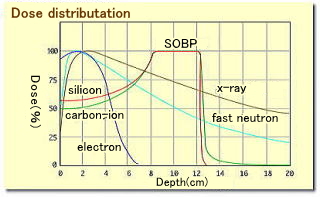Difference Between X-Ray and Particle Beam Radiation Therapies
X-rays are used in conventional radiation therapies, and they have a characteristic ability to powerfully penetrate our body. They are also used in diagnostic radiography. When X-rays pass through our bodies, they weaken as they release energy in their path and produce the treatment effects.
The energy of X-rays is distributed in such a way that it reaches its peak in the subcutaneous tissue, which is one to two centimeters under the skin; then they wane gradually. Although this effect depends upon the thickness of the body, X-rays still release 30% to 60% of their energy when they reach the other side of the body. This means that, when we try to irradiate the focus area, healthy tissues that exist above the focus area in the X-ray path absorb a higher radiation dose than the focus area does. X-rays also continue to give off radiation to tissues beyond the focus point.
To perform X-ray therapy, we must always consider the maximum dose that healthy tissues in the X-ray path can withstand. To minimize side effects, we need to moderate the radiation dose. There are many cases in which the dose turns out to be insufficient to eliminate the cancer completely.
Unlike X-rays, a particle beam penetrates the body to a certain depth, where it suddenly gives off high energy to the surroundings and then extinguishes. Using this characteristic, we can adjust the beam to release the most powerful energy in the focus area and little energy in the rest of its path.
We can use a higher dose of radiation on the cancerous focus area and achieve better results in the treatment with particle beam radiation as compared to X-ray therapy. It is also known that the same dose of radiation will cause more severe side effects if the field of irradiation is wider, and milder side effects if it is narrower. Particle beam radiation therapy allows us to narrow the field of irradiation in which a high dose is given to the cancerous focus area. As a result, side effects are minimized.
It has been reported that when particle beams are compared to the same physical dose of X-rays in biological testing, the proton beam is only slightly more effective than X-rays (approximately 1.1 times more), but the carbon-ion beam is 3 times more effective. (In the actual therapy, the carbon-ion dose needs to be set lower than the X-ray or proton dose to reduce side effects.) The carbon-ion beam exhibits strong effectiveness in treatment, especially against cancers with properties that are resistant to X-rays.
 |
|



